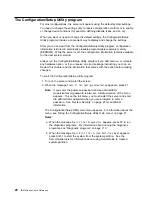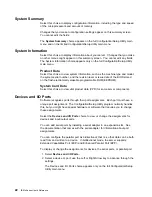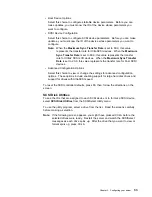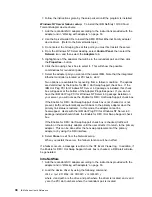
The Configuration/Setup Utility program configures the system hardware and PCI
IRQs. The program does not consider the requirements of the operating system or
the application programs. See “Resolving software configuration conflicts” on
page 31 for additional information.
Resolving hardware configuration conflicts
Use the following information to help resolve hardware configuration conflicts:
1. Run the Configuration/Setup Utility program to view and change resources
used by the system functions and the installed options. Record the current
settings before making any changes. (See “The Configuration/Setup Utility
program” on page 20 for instructions.)
2. Determine which adapter or device is causing the conflict. (See Chapter 6,
“Solving problems” for instructions.)
3. Change adapter jumpers or switches. Some devices use jumpers and switches
to define the system resources that the devices need. If the settings are
incorrect or set to use a resource that cannot be shared, a conflict occurs and
the device will remain deactivated by the configuration program.
4. Change system jumpers or switches. See “Changing jumper positions” on
page 103.
5. Remove the device or adapter. Some configurations are not supported. If you
must remove an adapter, see “Working with adapters” on page 53.
Resolving software configuration conflicts
The memory-address space and IRQs used by some hardware options might
conflict with addresses defined for use through application programs or the
expanded memory specification (EMS). (EMS is used only with DOS.)
If a conflict exists, one or more of the following conditions might exist:
The system cannot load the operating system.
The system does not work.
An application program does not operate, or it returns an error.
Screen messages indicate that a conflict exists.
To resolve conflicts, you can change the software or hardware configuration.
Note: Start the Configuration/Setup Utility program to view the addresses used by
your server functions. (See “The Configuration/Setup Utility program” on
page 20 for instructions.)
The best way to resolve memory-address conflicts is to change the addresses used
by the application program or the device driver. You can use the
Configuration/Setup Utility program to change addresses.
If a device driver is causing a memory-address conflict, refer to your
operating-system documentation or the documentation that comes with the device
drivers.
Chapter 3. Configuring your server
31
Содержание eServer 240 xSeries
Страница 1: ...User s Reference xSeries 240...
Страница 26: ...16 IBM xSeries User s Reference...
Страница 50: ...40 IBM xSeries User s Reference...
Страница 116: ...106 IBM xSeries User s Reference...
Страница 170: ...160 IBM xSeries User s Reference...
Страница 180: ...170 IBM xSeries User s Reference...
Страница 219: ...IBM Part Number 21P9014 Printed in the United States of America 21P9 14...
















































